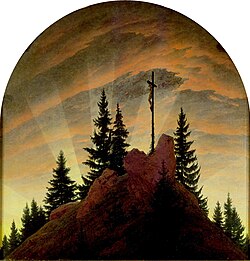Friedrich, Caspar David
Back

Image source
Wikimedia
https://en.wikipedia.org/wiki/File:Gerhard_von_K%C3%BCgelgen_portrait_of_Friedrich.jpg
Basic data
-
September 5, 1774 in Greifswald
-
†May 7, 1840 in Dresden
-
Maler, Zeichner
-
Dresden
Documents
Biographical information from the WeGA
No biographical data found
Biography not available due to one of the following causes:
- Data will be added at a later stage
- Research of the WeGA was without success so far
- It is a well known person where enough information is available online elsewhere, see e.g Wikipedia






![Chalk Cliffs on Rügen (1818). Friedrich married Christiane Caroline Bommer in 1818, and on their honeymoon they visited relatives in Neubrandenburg and Greifswald. This painting celebrates the couple's union.[29] (Source: Wikimedia) Chalk Cliffs on Rügen (1818). Friedrich married Christiane Caroline Bommer in 1818, and on their honeymoon they visited relatives in Neubrandenburg and Greifswald. This painting celebrates the couple's union.[29] (Source: Wikimedia)](https://upload.wikimedia.org/wikipedia/commons/thumb/a/a7/Caspar_David_Friedrich%27s_Chalk_Cliffs_on_R%C3%BCgen.jpg/250px-Caspar_David_Friedrich%27s_Chalk_Cliffs_on_R%C3%BCgen.jpg)


![The Abbey in the Oakwood (1808–1810). 110.4 × 171 cm. Alte Nationalgalerie, Berlin. Albert Boime writes, "Like a scene from a horror movie, it brings to bear on the subject all the Gothic clichés of the late eighteenth and early nineteenth centuries."[51] (Source: Wikimedia) The Abbey in the Oakwood (1808–1810). 110.4 × 171 cm. Alte Nationalgalerie, Berlin. Albert Boime writes, "Like a scene from a horror movie, it brings to bear on the subject all the Gothic clichés of the late eighteenth and early nineteenth centuries."[51] (Source: Wikimedia)](https://upload.wikimedia.org/wikipedia/commons/thumb/3/32/Caspar_David_Friedrich_-_Abtei_im_Eichwald_-_Google_Art_Project.jpg/250px-Caspar_David_Friedrich_-_Abtei_im_Eichwald_-_Google_Art_Project.jpg)
![The Sea of Ice (1823–1824), Kunsthalle Hamburg. This scene has been described as "a stunning composition of near and distant forms in an Arctic image".[56] (Source: Wikimedia) The Sea of Ice (1823–1824), Kunsthalle Hamburg. This scene has been described as "a stunning composition of near and distant forms in an Arctic image".[56] (Source: Wikimedia)](https://upload.wikimedia.org/wikipedia/commons/thumb/0/0c/Caspar_David_Friedrich_-_Das_Eismeer_-_Hamburger_Kunsthalle_-_02.jpg/250px-Caspar_David_Friedrich_-_Das_Eismeer_-_Hamburger_Kunsthalle_-_02.jpg)
![Man and Woman Contemplating the Moon (c. 1824). 34 × 44 cm. Alte Nationalgalerie, Berlin. A couple gaze longingly at nature. Dressed in "Old German" clothes, according to Robert Hughes, they are "scarcely different in tone or modelling from the deep dramas of nature around them".[60] (Source: Wikimedia) Man and Woman Contemplating the Moon (c. 1824). 34 × 44 cm. Alte Nationalgalerie, Berlin. A couple gaze longingly at nature. Dressed in "Old German" clothes, according to Robert Hughes, they are "scarcely different in tone or modelling from the deep dramas of nature around them".[60] (Source: Wikimedia)](https://upload.wikimedia.org/wikipedia/commons/thumb/3/3e/Caspar_David_Friedrich_-_Man_and_Woman_Contemplating_the_Moon_-_WGA08271.jpg/250px-Caspar_David_Friedrich_-_Man_and_Woman_Contemplating_the_Moon_-_WGA08271.jpg)



![Paul Nash, Totes Meer (Sea of the Dead), 1940–41. 101.6 x 152.4 cm. Tate Gallery. Nash's work depicts a graveyard of crashed German planes comparable to The Sea of Ice (above).[73] (Source: Wikimedia) Paul Nash, Totes Meer (Sea of the Dead), 1940–41. 101.6 x 152.4 cm. Tate Gallery. Nash's work depicts a graveyard of crashed German planes comparable to The Sea of Ice (above).[73] (Source: Wikimedia)](https://upload.wikimedia.org/wikipedia/commons/thumb/9/9a/Totes_Meer_%28Dead_Sea%29_1940-1_Paul_Nash.jpg/250px-Totes_Meer_%28Dead_Sea%29_1940-1_Paul_Nash.jpg)





